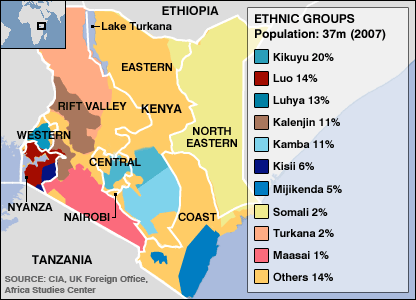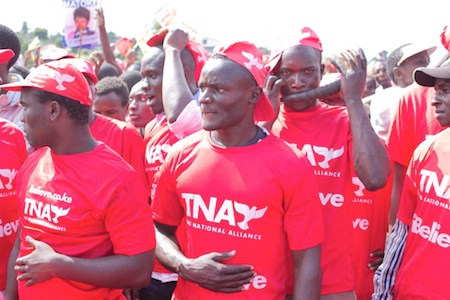To understand what’s going on in Kenya’s politics and to understand the nature of its upcoming March 4 presidential election, you have to understand that Kenyan politics are based on ethnic identity, not ideology.![]()
Due to the nature of Kenyan election rules, a presidential candidate has to build an electoral coalition larger than any single ethnic group in the country — a candidate must win not only a 50% majority of the votes, but 25% of the vote in at least 24 of Kenya’s 47 counties.
So it’s not enough for deputy prime minister and former finance minister Uhuru Kenyatta to win a plurality of the vote based largely on the support of his Kikuyu ethnic group, Kenya’s largest. Nor would it be enough for Kenyan prime minister Raila Odinga to win a plurality on the strength of his own Luo ethnic group.
That means the winning candidate will have to craft a coalition based on many different ethnic groups, and Kenyatta and Odinga have both named running mates of differing ethnic groups. In light of the aftermath of the 2007 election, when incumbent Mwai Kibaki won narrow reelection against Odinga amid charges of rigging the vote count, political riots quickly descended into ethnic violence. But the 2013 elections will also largely be determined on the basis of ethnicity-based coalitions, which only underscores the fear that Kenya could undergo another round of destabilizing political violence.
Identifying Kenya’s ethnic groups
In the broadest terms, Kenya’s ethnic groups can be divided into the Bantu and the Nilotic peoples.
The Bantu comprise by far the largest group of Kenyans, roughly two-thirds of Kenya’s 43 million people. The Bantu ethnic groups derive from people who originally came to Kenya from western and central Africa 2,000 years ago during the so-called Bantu expansion. The Bantu languages are derived from the Niger-Congo language family — you are likely to be most familiar with Swahili, a Bantu language that, along with English, is one of Kenya’s two official languages.
The Nilotic peoples are the second-largest group, comprising about one-third of Kenyans. Unlike the Bantu, they originally came to Kenya from what is today South Sudan, and they are somewhat more rural than their Bantu counterparts. They speak languages derived from the Nilo-Saharan language family, which includes the Dholuo language of Kenya, but also Nubian and other languages throughout Sudan and north-central Africa.
But that only explains so much about Kenya’s incredibly complex range of ethnic groups, which are divided even further on the basis of regional, linguistic and other cultural and historical criteria. Notably, as the useful map below shows, much of Kenya’s population resides in the highlands that stretch from the Rift Valley and along the western border through the central heartland of Kenya.

Accordingly, there are five major ethnic groups and countless others that form a mosaic of politically mobilized chess pieces, any of which can come together to form a political and governing alliance. Alliances are not based on Bantu / Nilotic lines, and from one election to the next, one ethnic group may support a candidate that it virulently opposed in the prior election, making Kenyan politics incredibly unique — and also difficult to understand.
As recently as 2005, Odinga and Kenyatta found themselves on the same side, politically, in opposition to a constitutional referendum
The five largest groups are as follows:
- The Kikuyu, a Bantu group, comprise 17% of the population (according to the 2009 census) that, as the map shows, reside largely in the central highlands of Kenya around Mount Kenya north of Nairobi.
- The Luhya, also a Bantu group, comprise 14% of the population and reside in the highlands of Western Province, along the Ugandan border just north of Lake Victoria.
- The Kalenjin, a Nilotic group, comprise 13% of the population and reside in the Rift Valley highlands and are perhaps best known for producing some of the Kenya’s best runners, who routinely rank among the fastest in the world.
- The Luo, a Nilotic group, comprise 10% of the population and reside in the highlands of Nyanza province, adjacent to Lake Victoria, bordering both Uganda and Tanzania — Barack Obama, Sr., the father of the current U.S. president, was from the Luo ethnic group.
- The Kamba, another Bantu group, comprise 10% of the population and reside in the area east of Nairobi, where the highlands begin to level off into Kenya’s lowlands.
Smaller Bantu groups include the Kisii (6% of the population), the coastal Mijikendra (5%) and the Meru (4%); smaller Nilotic groups include the Turkana (2.5%) of the far-north Rift Valley and the distinctive, semi-nomadic Maasai (2.1%) of the highlands near the Tanzanian border. Another 9% of the population belongs to an even wider set of smaller ethnic groups.
Parsing Kenya’s historical ethnic governing coalitions
Jomo Kenyatta, the first president of Kenya, from 1964 to 1978, was Kikuyu, and his first vice president, Jaramogi Oginga Odinga, was Luo. Odinga, however, parted ways with Kenyatta in 1965, setting the stage for a rivalry that’s now playing out in the March 4 presidential election — Jomo’s son Uhuru is now challenging Jaramogi’s son Raila for the presidency.
In 1978, Daniel arap Moi, from the Kalenjin group, came to power, and held on to power through a coalition based on cooperation with the Kikuyu, by exploiting ethnic insecurities, political violence and fraudulent elections.
When he stepped down in 2002, he preferred Uhuru Kenyatta as his successor; instead, Kibaki, who served as arap Moi’s vice president from 1978 to 1988 before switching to the opposition (he also served as finance minister, mostly under Jomo Kenyatta, from 1969 through 1981) defeated Kenyatta by a wide margin. It helped that both Kenyatta and Kibaki were Kikuyu, so Kibaki won (with the support of Raila Odinga) with a coalition that included both Kikuyu and Luo voters.
The 2007 election saw a breakdown between the broad-based 2002 coalition, in large part due to a 2005 constitutional referendum that split Kenya on mostly ethnic-based lines. So Kibaki sought reelection on a new coalition based largely on Kikuyu and Kalenjin support. Therefore, he ran with the support of his 2002 rival (Kenyatta) against one of his chief supporters from 2002 (Odinga).
The 2013 ethnicity-based coalitions
This time around, the alliances have once again shifted.
Kenyatta is running under the banner of the Jubilee coalition, which includes his own party, The National Alliance (TNA rally pictured above) and the United Republican Party of William Ruto, a Kalenjin, former agriculture minister, and Kenyatta’s running mate. Kenyatta and Ruto were on opposite sides in the 2007 election, however (with Kenyatta supporting Kibaki and with Ruto supporting Odinga), and they have both been indicted by the International Criminal Court for crimes against humanity for their alleged role in perpetrating ethnic violence, in large part against each other’s ethnic groups.
Confused yet? Just wait.
Odinga is the presidential candidate the Coalition for Reforms and Democracy (CORD), which includes the Orange Democratic Movement (ODM), the remnants of the ‘orange’ coalition that once included Kenyatta (so named because it was formed during the 2005 Kenyan referendum; opponents were ‘orange,’ and proponents were ‘banana’), and is now essentially the personal vehicle for Odinga’s ambitions. CORD also includes the Wiper Democratic Movement, headed by Kalonzo Musyoka, from the Kamba group, who is Odinga’s 2013 running mate and has served as Kenya’s vice president since 2008 (he ran for president in his own right in 2007 and won just 9%, placing third behind Kibaki and Odinga). Finally, it includes the Forum for the Restoration of Democracy–Kenya (FORD-Kenya), led by Eugene Wamalwa, also a Luhya.
There’s one final piece to the puzzle — deputy prime minister Musalia Mudavadi, a Luhya, who was Odinga’s 2007 running mate. He left the ODM when it was clear that Odinga would win the presidential nomination. He then formed his own new vehicle, the United Democratic Forum, and briefly joined the Jubilee coalition. But turmoil over whether Kenyatta or Mudavadi would head the Jubilee ticket in 2013 led to a breakdown and Mudavadi left the Jubilee coalition as well to run for president in his own right under a hastily assembled Amani coalition that includes the party of Eugene Wamalwa, another Luhya, and the once-powerful Kenyan African National Union (KANU) that dominated Kenyan government in the arap Moi years and is now led by his son, Gideon Moi (but used to support Kenyatta).
Peter Kenneth, who leads the ‘Eagle’ coalition, is running on the only major ticket not based on ethnic lines.
The bottom line on ethnicity and politics in the 2013 election
In the grand scheme of things, the actual parties described above aren’t incredibly important in following the presidential race — it essentially comes down to two major coalitions, a Kikuyu/Kalenjin ‘Jubilee’ alliance supporting Kenyatta and a Luo/Kamba/Luhya ‘CORD’ alliance supporting Odinga. It’s also worth keeping in mind that some Luhya are sticking with Mudavadi (who polls far behind in third or fourth place) and the non-ethnicity-based Eagle alliance behind Kenneth.
The state of the race gives Odinga a narrow lead, with Kenyatta rapidly making up lost ground — it may well turn out that the Luhya become a ‘swing’ ethnic group. If Mudavadi does well enough, he will do so by winning a large number of Luhya votes that might otherwise have gone to Odinga. In a potential runoff, however, those Luhya voters could likely return to Odinga.
Or not, possibly, if Mudavadi and the KANU support the Jubilee coalition during the second round with a strong endorsement for Kenyatta.
All of which makes the next three weeks an incredibly tense time, not only for Kenya, but for all of east Africa.
Special thanks to Andrew Novak for his crucial assistance.

2 thoughts on “Making sense of Kenya’s ethnopolitical alliances”